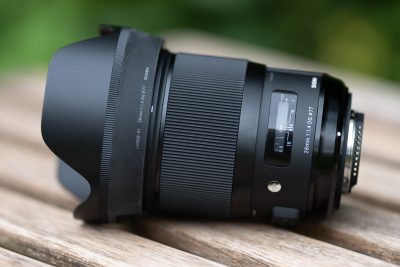Sigma 28mm f1.4 Art review
-
-
Written by Thomas
Intro
The Sigma 28mm f1.4 Art is a medium wide-angle lens designed for full-frame bodies and available in Nikon F, Canon EF, Sony E and Sigma mounts, with the Leica L version arriving later in 2019. Announced in September 2018, it’s Sigma’s 10th large aperture full-frame lens in the renown Art series ranging from 14mm up to 135mm focal length and fills a gap in Sigma’s wide lineup between their 24mm and 35mm options.
On a full-frame camera the Sigma 28mm f1.4 Art delivers a field-of-view that’s 12 degrees wider than the standard 35mm lens (75 vs 63 degrees) and 9 degrees narrower than from a 24mm lens. Use it on an APS-C/DX crop sensor and the Sigma 28mm f1.4 Art delivers a field of view that is equivalent to a 42mm lens. Combined with a bright f1.4 focal ratio it is ideal for available-light use and should also deliver shallow depth-of-field effects and background blur.
To find out whether the optical performance of the new 28mm f1.4 Art makes it a worthy member of Sigma’s Art line I tested it on a 46MP Nikon Z7 (with FTZ-adapter) and compared it against the Zeiss Otus 28mm f1.4 and the Nikon 28mm f1.4E ED.
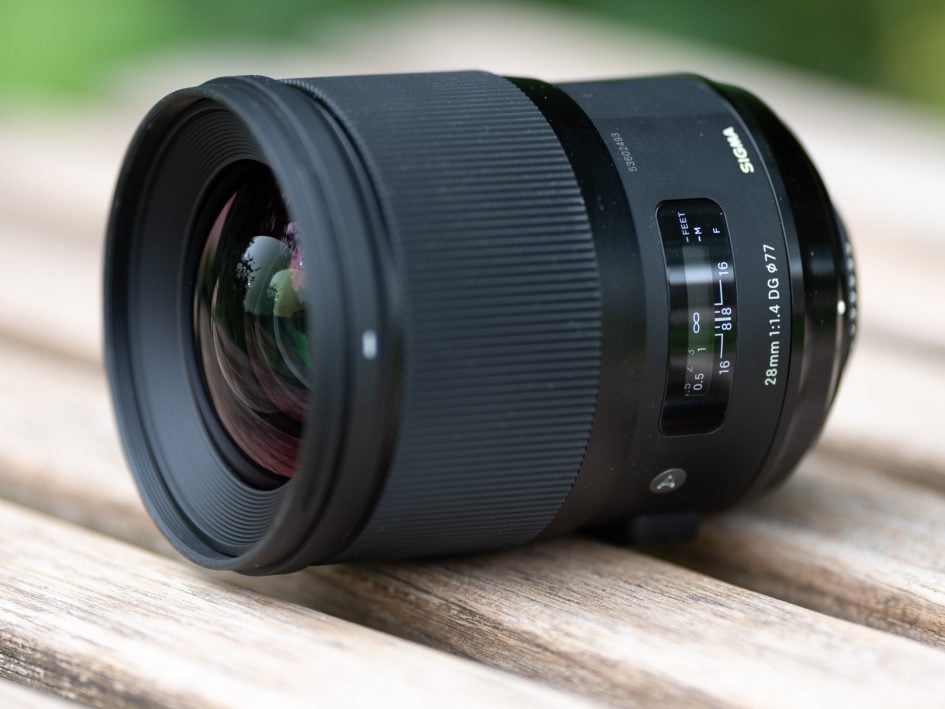
Facts from the catalog
As usual I’ll have a look at the technical data of the Sigma 28mm f1.4 Art first. I’ve rated the features with a [+] (or [++]), when it’s better than average or even state of the art, a [0] if it’s standard or just average, and [-] if there’s a disadvantage. For comparison I use the Nikon 28mm f1.4E ED and the Zeiss Otus 28mm f1.4 (“Nikon” resp. “Zeiss Otus” for short).
Size (diameter x length): With a diameter of 83mm (3.3in.) the length of the lens varies with the mount: with a Nikon F-mount it’s 106mm (4.2in.), with a Sony E-mount it’s 135mm (5.3in.). Put a Nikon FTZ-adapter on the F-mount version to shoot on a Nikon Z body and you end up with 137mm length. The lens hood adds 42mm (1.7in.) and is 101mm in diameter bringing the total length to about 18cm (7.0in.) in front of a modern mirrorless body. The lens is clearly showing its heritage as a DSLR design that has to cope with the larger flange distances – but that is true for all alternatives considered here. The Nikon is just a little shorter while the Zeiss Otus is about 2cm wider and 2cm longer. [0]
Weight: 848g (29.9 oz.) in the F-mount version plus 49g for the lens hood. Sigma does not list the weight of the E-mount version which has a 28mm longer “throat” but I assume that’s an additional 100g (3.5 oz.). If you use the F-mount lens on a Nikon Z body the FTZ-adapter adds 133g (4.7 oz.). The Nikon weighs only 645g (22.8 oz.) plus 29g lens hood. The Zeiss Otus is the elephant in this comparison at 1310g (46.2 oz.) plus 62g for the lens hood. [0]
Optics: The lens is a pretty complex design with 17 elements (including 5 special dispersion elements and three aspherical element) in 12 groups. That makes 24 glass/air surfaces where reflections can cause problems. There’s fluorine coating on the front to repel water, dust, and dirt and should make for easier cleaning. The Nikon has 14 elements in 11 groups, the Zeiss Otus has 16 elements in 13 groups. [+]
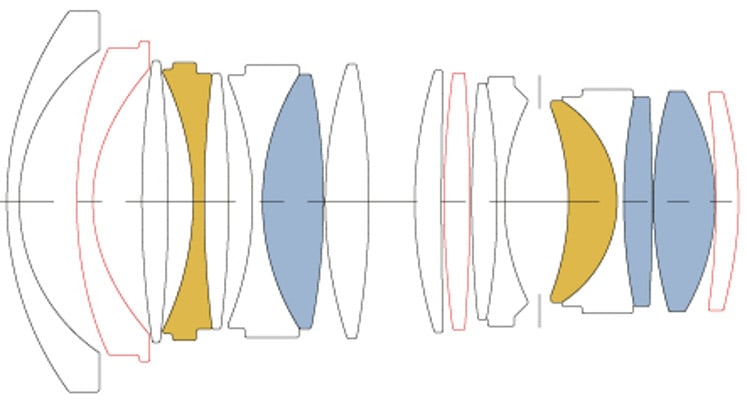
Closest focus distance is 0.25m (9.8in.) in manual focus with a magnification of 1:4.5. This results in a working distance of only 10cm even when the lens hood is removed. A magnification of 1:10 is achieved at 0.42m distance. Both the Nikon and the Zeiss Otus achieve slightly less magnification of around 1:5.5. [0]
Filter-thread: 77mm, just like the Nikon. This is the widely used professional standard. The Zeiss Otus takes humongous 95mm filters. [+]
Image stabilization: No optical stabilization of the lens. The Sony A7 or Nikon Z bodies provide built-in sensor-shift stabilization. Same with the alternatives. [0]
Auto focus: Built-in AF drive. Manual-focus override is by simply turning the focus ring. The focus ring has a direct linear mechanical coupling between the focus ring and the focus action and offers distance and dof markings. The ring turns the same direction as Sony/Canon users expect, but that is the opposite of what Nikon users are used to. Various characteristics of the AF can be adapted via Sigma’s USB dock with their Optimization Pro software. The Nikon naturally turns the correct way for Nikon users. The Zeiss Otus is manual focus only with a large and clear scale and turns the way that is correct for the respective mount. [+]
Covers full frame/FX or smaller. Same with the alternatives. [+]
Price: The lens currently sells for 1200 EUR (incl. 19% VAT) / 1400 USD. The Nikon is 2000 EUR / 1800 USD while the Zeiss Otus is the most expensive at 4000 EUR / 5000 USD. [+]
The Sigma Art lens comes with a padded pouch plus strap and the lens hood is included. It is reversible for transport and has a locking mechanism to prevent it from accidentally falling off. Beware though that the front of the lens hood is slightly rounded. So setting the lens (and camera) down on its lens hood risks toppling it over. The Nikon has a soft pouch and the lens hood has no lock. The Zeiss Otus comes with the lens hood but without a pouch. [+]
Sigma’s service can change the mount of the lens between Nikon, Canon, Sony, Sigma, and L-mount (at a cost). This is a unique feature that no other manufacturer offers. [++]
Aperture ring: no, just like the Nikon. The aperture is actuated electromagnetically in the Nikon-version too which makes it the equivalent of a modern E-type Nikon lens and puts away with the mechanical coupling that Nikon uses on all older lenses. The Zeiss Otus offers an aperture ring with 1/2 stop clicks and a mechanical actuation of the aperture. [0]
Sealing: yes, a rubber grommet at the lens-mount plus further special weather-sealing throughout the construction, just like the Nikon. The Zeiss Otus is similarly sealed inside but lacks the rubber sealing at the lens-mount. [+]
The score in the “features-department” is 0[-]/5[0]/9[+], so the lens is quite well-featured with the unique option to get the lens-mount swapped.
Two wide-angle prime lenses
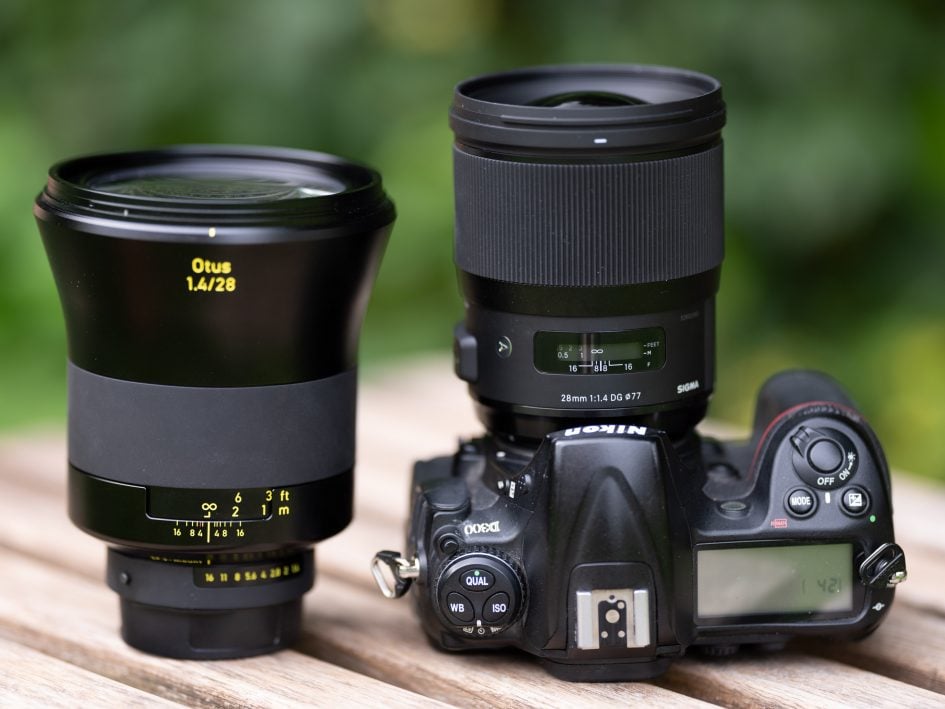
Above: Zeiss Otus 28mm f1.4 (left), Sigma 28mm f1.4 Art (right)
Alternatives
If you want a 28mm lens with an f1.4 focal ratio and autofocus there is only one alternative:
- Nikon offers the AF-S 28mm f1.4E ED for F-mount. It’s an optical design from 2017 which can be used via Nikon’s FTZ-adapter also on their latest mirrorless Z bodies. See my Nikon 28mm f1.4E review where it came Highly Recommended when tested on a 36MP Nikon D810. It is around 50% more expensive than Sigma’s 28mm f1.4 Art.
Other alternatives include manual focus lenses or lenses with slower focal ratios. If that’s not to your liking you need to resort to either 24mm or 35mm lenses of which there are plenty:
- Zeiss has the only other 28mm f1.4 on the market, their Otus 28mm f1.4 from 2016 for a staggering 4000 EUR / 5000 USD. Beyond the price, the biggest disadvantage of the Zeiss Otus is that it’s manual focus only and it is a very large and heavy lens. But its optical performance is unsurpassed and got it a Highly Recommended in my Zeiss Otus 28mm f1.4 review. Zeiss also has the manual focus Distagon 28mm f2.0.
- Canon offers the EF 28mm 1.8 USM from 2015 for 440 EUR / 460 USD. It’s 74x56mm and weighs 310g.
- Sony mirrorless owners can get the FE 28mm f2.0 (400 EUR / 450 USD) from 2015 which is the smallest and lightest lens in the group at 64x60mm and 200g. A pair of optional adapters transform it into a 21mm ultra-wide or 16mm Fisheye. See my Sony FE 28mm f2 review-so-far.
How big are the differences between 24mm, 28mm, and 35mm focal length? Here is the angle of view that the Sigma 28mm f1.4 Art covers on a full-frame body compared to other lenses:

Above: Sigma 28mm f1.4 Art (left), Zeiss Otus 28mm f1.4 (right)

Above: Nikon Z 24-70mm f4.0 S at 24mm (left), 35mm (right)
Focus
Focus accuracy and repeatability is critical to consistently produce sharp shots especially with large aperture lenses. Repeatability (the accuracy of focus on the same subject after repeated focus-acquisition) of this lens is very good (measured 99.3% in Reikan FoCal) with no outliers over a series of 40 shots. And there is no focus variation whether the lens focuses from a closer distance or from infinity.
The lens focuses in around 0.3 sec on a Nikon Z7 (with FTZ-adapter) from infinity to 0.42m (1:10 magnification), which is very fast. The Nikon is much slower at 0.6 sec) but focusing on the Zeiss Otus is clearly the slowest as it is manual focus only. The focus ring of the Sigma is 36mm wide and easy to grip. Its movement is a bit stiff but it can be operated with one finger. Both the Nikon and the Zeiss Otus have focus rings that run smoother.
AF-operation of the lens is pretty quiet from the outside and if you record video with the built-in microphone the AF-drive produces some sound although not too annoying. As you pull focus, you’ll notice some focus breathing: the image becomes 3% more magnified when I adjusted the focus from infinity to 0.42m. This should be OK when shooting videos. The Nikon increases its magnification by 4% and the focus noise is a bit more prominent. The Zeiss Otus naturally is completely quiet.
Next check out my quality results!
Check prices on the Sigma 28mm f1.4 ART at Amazon, B&H, Adorama, or at WEX. Alternatively get yourself a copy of my In Camera book or treat me to a coffee! Thanks!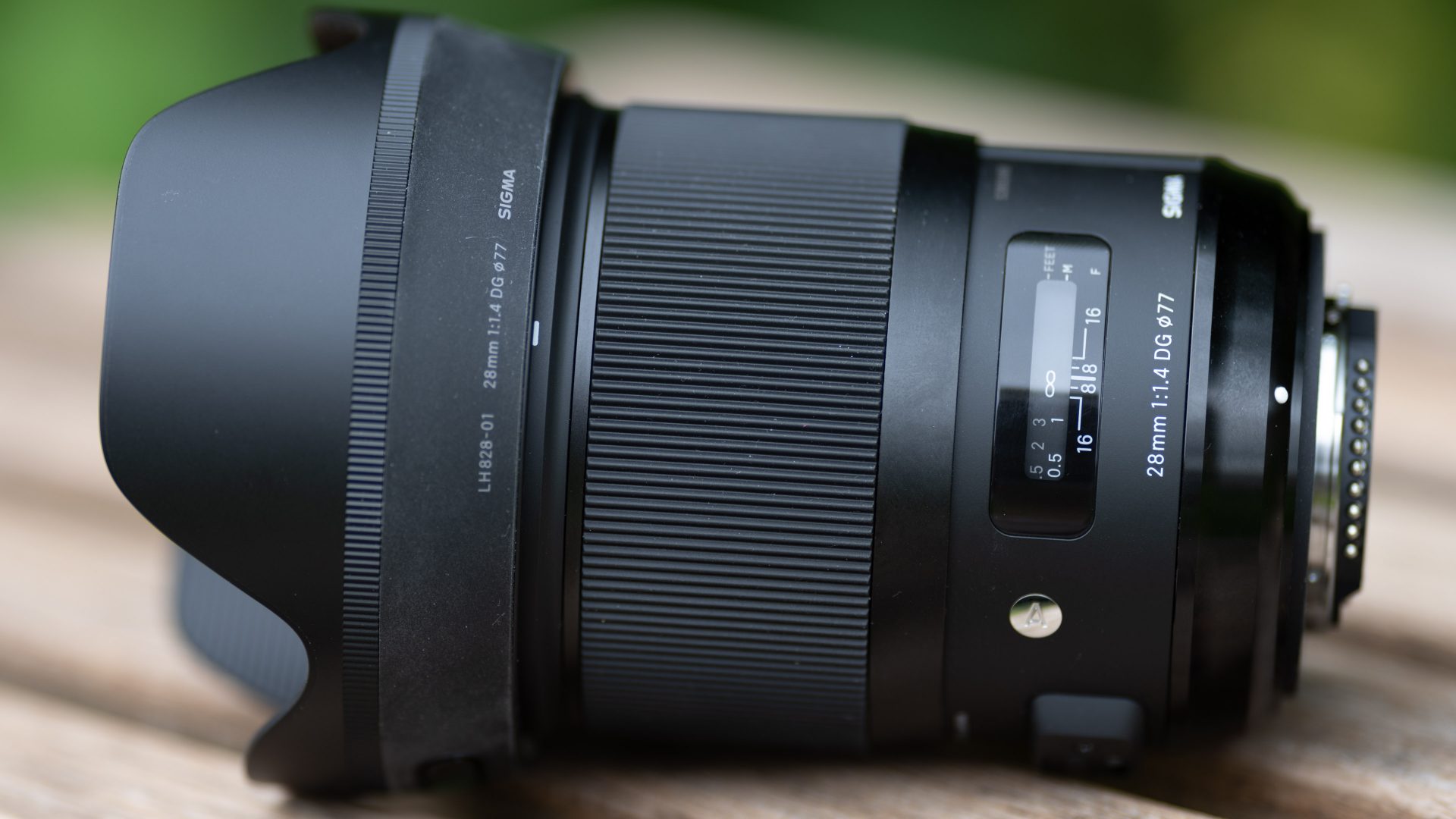
 The Sigma 28mm f1.4 Art is a mild wide-angle prime lens designed for full-frame bodies and joins the highly-respected Art series, slotting between the existing 24mm and 35mm models. Originally designed for Canon, Nikon and Sigma DSLRs, the 28mm Art (as well as the other prime lenses in the Art series) is now also available for Sony E-mount and will additionally become available for the L-mount supported by Leica, Panasonic and Sigma. This together with the unique ability to have the lens mount changed in service makes the Art line from Sigma the most versatile in the market regarding adaptability to different camera systems. My testing revealed the optical performance of the Sigma 28mm f1.4 Art has only one flaw: It is not the sharpest model I’ve tested in the center. But otherwise the lens is a worthy addition to the Art line: extra sharp in the corners of a full-frame sensor with almost no coma, very good resistance against flare, glare and ghosting plus nice background Bokeh and low color aberrations. Together with thorough weather-sealing, solid build quality, and the option to have the mount changed the lens justifies its price and earns a Highly Recommended.
The Sigma 28mm f1.4 Art is a mild wide-angle prime lens designed for full-frame bodies and joins the highly-respected Art series, slotting between the existing 24mm and 35mm models. Originally designed for Canon, Nikon and Sigma DSLRs, the 28mm Art (as well as the other prime lenses in the Art series) is now also available for Sony E-mount and will additionally become available for the L-mount supported by Leica, Panasonic and Sigma. This together with the unique ability to have the lens mount changed in service makes the Art line from Sigma the most versatile in the market regarding adaptability to different camera systems. My testing revealed the optical performance of the Sigma 28mm f1.4 Art has only one flaw: It is not the sharpest model I’ve tested in the center. But otherwise the lens is a worthy addition to the Art line: extra sharp in the corners of a full-frame sensor with almost no coma, very good resistance against flare, glare and ghosting plus nice background Bokeh and low color aberrations. Together with thorough weather-sealing, solid build quality, and the option to have the mount changed the lens justifies its price and earns a Highly Recommended.



